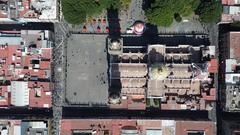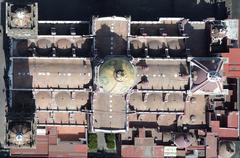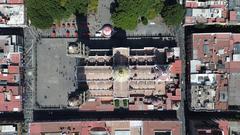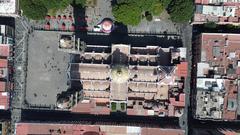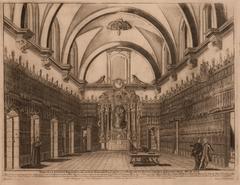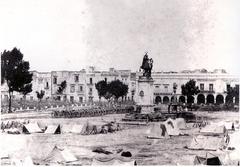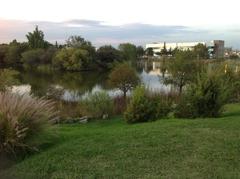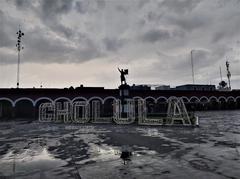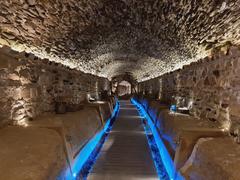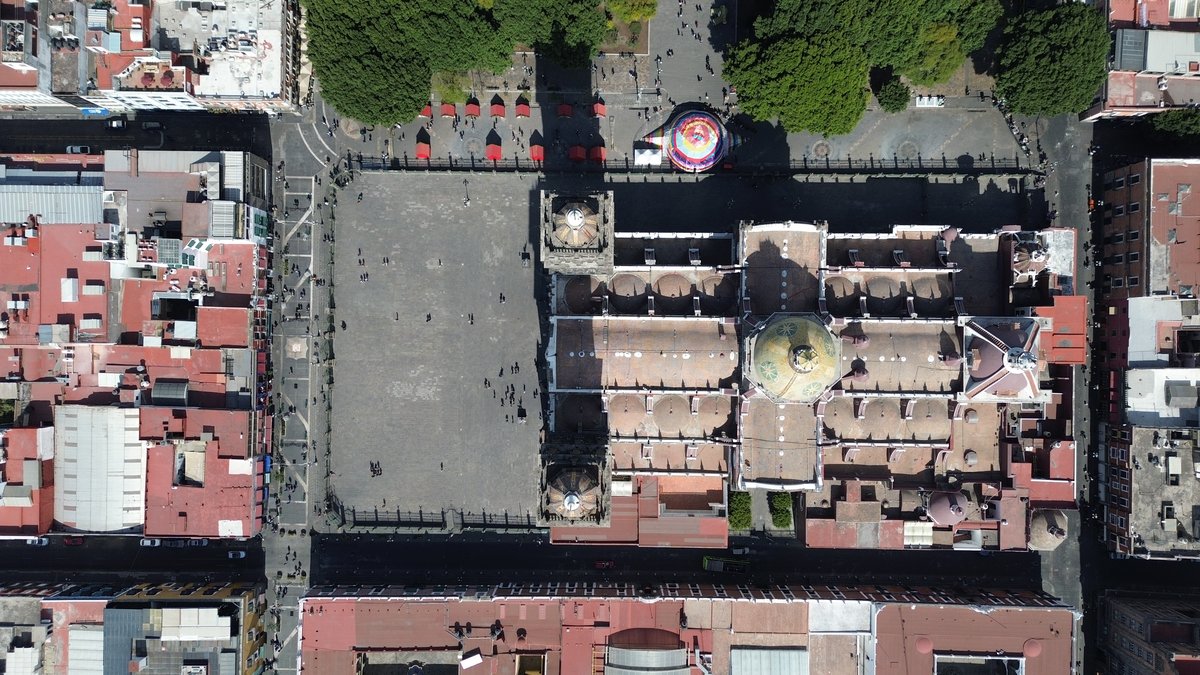
Puebla Cathedral: Visiting Hours, Tickets, and Historical Sites in Puebla City
Date: 14/06/2025
Introduction
Located in the heart of Puebla City, Mexico, the Puebla Cathedral (Catedral Basílica de Puebla) stands as a symbol of the city’s colonial past, religious devotion, and architectural innovation. As one of Mexico’s most celebrated religious landmarks, the cathedral is renowned for its towering 69-meter bell towers—among the tallest in the country—and its harmonious blend of Renaissance, Baroque, and Neoclassical architectural styles. Since construction began in 1536, the cathedral has evolved over centuries, reflecting the artistic ambitions of New Spain. Today, it welcomes thousands of visitors annually, anchoring Puebla’s vibrant historic center and offering free general admission, guided tours, and year-round religious celebrations. This guide provides comprehensive information on Puebla Cathedral visiting hours, ticketing, accessibility, historical background, and travel tips to help you make the most of your visit (Kurby Blog; History Wanderer; Sacred Destinations).
Table of Contents
- Introduction
- Visiting Information
- Travel Tips
- Special Events
- Historical Overview
- Notable Historical Events
- Architectural Highlights
- Visuals and Media Suggestions
- Frequently Asked Questions (FAQ)
- Conclusion
- Location and Access
- Historical Background
- Interior Highlights
- Practical Visitor Tips
- Nearby Attractions
- Safety and Visitor Experience
- Essential Contact Information
- Summary of Key Information
- References and Further Reading
Visiting Information
Opening Hours
- Monday to Saturday: 7:00 AM – 7:00 PM
- Sunday: 7:00 AM – 8:00 PM
- Special events or holidays: Hours may vary; check the official cathedral website for updates (en.travelbymexico.com).
Tickets and Admission
- General Admission: Free
- Guided Tours: May require a fee; available in English and Spanish. Book onsite or through authorized tour providers.
Guided Tours
Guided tours provide in-depth insights into the cathedral’s architecture, art, and history. Reservations are recommended, particularly during peak tourist seasons or major religious festivals.
Accessibility
The cathedral is wheelchair accessible, with ramps at main entrances and assistance available for visitors with mobility needs.
Travel Tips
- Best Time to Visit: Early mornings or late afternoons for fewer crowds and optimal lighting.
- Dress Code: Modest attire is required; cover shoulders and knees, and remove hats inside.
- Photography: Allowed in most areas, but flash and tripods may be restricted, especially during services.
- Safety: The cathedral and historic center are generally safe; exercise standard precautions and avoid isolated areas at night (myglobalviewpoint.com).
Special Events
Major religious celebrations such as Holy Week, the Feast of the Immaculate Conception, and Christmas are held at the cathedral. During these times, expect large crowds and potential changes in visiting hours.
Historical Overview
Origins and Foundation
Puebla Cathedral was established alongside the city’s founding in 1531, serving as a central anchor for Puebla’s colonial layout. Construction began in 1536, with the current structure’s cornerstone laid in 1575 under architect Francisco Becerra (Kurby Blog). The cathedral was consecrated in 1649, with work on the bell towers continuing into the late 18th century.
Architectural Evolution
The cathedral is celebrated for its fusion of Renaissance symmetry, Baroque ornamentation, and Neoclassical refinement. Its exterior is constructed from local cantera stone and features Talavera tile accents, reflecting Puebla’s artistic heritage. The Latin cross floor plan and opulent interior altarpieces showcase the evolving tastes of colonial Mexico (History Wanderer; Traveling Ness).
Cultural and Religious Significance
Consecrated as the seat of the Archdiocese of Puebla, the cathedral is the city’s spiritual heart, hosting daily Mass, sacraments, and major liturgical celebrations. It is home to important artworks by artists such as Cristóbal de Villalpando.
UNESCO World Heritage Status
Puebla’s historic center, including the cathedral, was designated a UNESCO World Heritage Site in 1987 in recognition of its architectural and cultural importance (UNESCO).
Notable Historical Events
Over centuries, Puebla Cathedral has played a central role in the city’s civic, spiritual, and political life. It has witnessed colonial rule, the Mexican War of Independence, and the Reform era, standing as a monument to Puebla’s resilience.
Architectural Highlights
- Bell Towers: The tallest in Mexico, rising to 69 meters (226 feet), house ten bells including the massive Campana María (Discover Puebla).
- Main Altar: A Neoclassical masterpiece by Manuel Tolsá.
- Choir and Organ: Noted for intricate woodwork and one of the oldest pipe organs in the Americas.
- Chapels: Fourteen side chapels, richly decorated with Baroque and Neoclassical art.
- Stained Glass and Marble: Vibrant windows and marble sculptures.
- Talavera Tiles: Distinctive ceramics emblematic of Puebla’s artistry.
Visuals and Media Suggestions
- Include high-quality images of the cathedral’s façade, bell towers, altar, and interior chapels.
- Use alt text such as “Puebla Cathedral bell towers - tallest in Mexico” or “Baroque altar inside Puebla Cathedral.”
- Embed an interactive map showing the cathedral’s location in Puebla’s historic center.
- Provide links to virtual tours if available.
Frequently Asked Questions (FAQ)
Q: What are Puebla Cathedral’s visiting hours?
A: Monday to Saturday, 7:00 AM – 7:00 PM; Sunday, 7:00 AM – 8:00 PM.
Q: Is admission free?
A: Yes, general admission is free. Fees may apply for special tours or exhibitions.
Q: Are guided tours available?
A: Yes, in multiple languages; bookings are recommended.
Q: Is the cathedral wheelchair accessible?
A: Yes, with ramps and assistance at entrances.
Q: Are photography and videography allowed?
A: Permitted, but flash and tripods may be restricted.
Q: What’s the best time to visit?
A: Weekdays and off-peak hours for a quieter experience; religious festivals for cultural immersion.
Conclusion
Puebla Cathedral is not only an architectural marvel but also a living testament to the city’s colonial heritage and enduring faith. Its soaring towers, intricate chapels, and vibrant cultural life offer a profound experience for every visitor. Plan ahead, explore nearby attractions, and immerse yourself in the heart of Puebla’s historic center.
Location and Access
The cathedral is centrally located next to Puebla’s Zócalo at 16 de Septiembre between 3 and 5 Oriente, Centro, Puebla, Pue., 72000. It is easily accessible on foot from anywhere in the historic center, with public transportation, taxis, and ride-sharing services available (en.travelbymexico.com; thepresentperspective.com).
Historical Background
Construction began in 1575, with major phases completed between the 17th and 18th centuries. The cathedral’s dedication to the Immaculate Conception reflects Puebla’s deep Catholic roots, and its completion was overseen by key figures like Bishop Don Juan de Palafox y Mendoza (en.travelbymexico.com).
Interior Highlights
- Main Altar: Designed by Manuel Tolsá, a Neoclassical masterpiece.
- Kings’ Altar: Baroque creation by Pedro Garcia Ferrer.
- Choir Stalls and Organ: Noteworthy for their artistry and historical significance.
- Stained Glass: Fills the interior with colorful light, adding to the contemplative atmosphere (myglobalviewpoint.com).
Practical Visitor Tips
- Modest Dress is Required: Shoulders and knees covered.
- Guided Tours: Local guides can be found near the Zócalo for in-depth exploration (thepresentperspective.com).
- Accessibility: Ramps at entrances, some uneven historic flooring.
- Best Visiting Times: Early mornings, late afternoons, or weekdays.
Nearby Attractions
- Zócalo: Puebla’s main square, surrounded by colonial buildings.
- Capilla del Rosario: Ornate 17th-century chapel (mexicotravelsecrets.com).
- Templo de Santo Domingo: Noted for Baroque artistry.
- Museo Amparo: Showcases pre-Columbian and colonial art.
- Biblioteca Palafoxiana: The oldest library in the Americas (TravelAge West).
Safety and Visitor Experience
Puebla’s historic center is safe and lively, with a welcoming atmosphere for tourists. Street musicians, festivals, and a blend of locals and visitors create a dynamic environment, while the cathedral offers a peaceful refuge (myglobalviewpoint.com).
Essential Contact Information
- Phone: +52 (222) 232 3803, +52 (222) 232 2316
- Address: 16 de Septiembre between 3 and 5 Oriente, Centro, Puebla, Pue., 72000 (en.travelbymexico.com)
- Official Website: www.catedraldepuebla.mx
Summary of Key Information
Puebla Cathedral is an essential destination for anyone interested in Mexico’s colonial history, religious traditions, and architectural heritage. Its grandeur, accessibility, and prime location in Puebla’s historic center make it an enriching experience for all visitors. For up-to-date hours, event schedules, and guided tours, consult the official website and consider using travel resources such as the Audiala app for personalized recommendations (UNESCO; Traveling Ness; Sacred Destinations).
References and Further Reading
- From Past to Present: The Evolution of Puebla, Mexico’s Architecture, 2024, Kurby Blog
- Puebla Cathedral History, 2024, History Wanderer
- Catedral de Puebla Interest Facts & Information Travel Guide, 2024, Holly Melody
- Puebla Cathedral, Sacred Destinations
- Puebla Travel Guide, 2024, Discover Puebla
- Puebla Cathedral History and Architecture, 2024, CDMX Secreta
- Puebla Mexico Travel Guide, 2024, The Present Perspective
- Puebla Worth Visiting?, 2024, Mexico Travel Secrets
- Puebla Cathedral UNESCO Listing, 1987, UNESCO World Heritage Centre
- Things to Do in Puebla Mexico, 2024, Traveling Ness
- Best Time To Visit Puebla, 2024, Best Time To
- Free Guided Walking Tours Puebla, 2024, Kayra Tours
For more insights and travel tips, download the Audiala app and follow us on social media for the latest updates on Puebla’s historical and cultural attractions.
